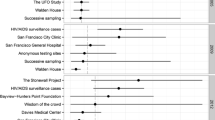Abstract
Comparative studies on regional HIV seroprevalence or seropositivity rate among injection drug users (IDUs) have focused primarily on assessing the risk factors for HIV infection. This study used a nonparametric analytic approach, known as standardization and decomposition, to to compare HIV seropositivity rates among IDUs between low- and high-HIV-prevalence regions in the United States. The regional difference in HIV seropositivity rate was decomposed into different components: (1) a “rate effect,” which was attributed to the differences in factor-specific rates, and (2) “compositional factor effects,” which were attributed to the differences in distributions of sociodemographic factors across regions. The analytic results show that the regional difference in HIV seropositivityrate was considerable (21.04%); however, the difference would be adjusted down to 17.65% if sociodemographic factors were proportionally distributed across the regions. Differential distribution of ethnic groups between the two regions accounted for about 15.02% of the regional difference in HIV seropositivity rate. The application of the standardization and decomposition method provides HIV researchers with opportunities to look at familiar data from a different perspective.
Similar content being viewed by others
References
Barclay, G. W. (1958). Techniques of population analysis. New York: Wiley.
Battjes, R. J., Pickens, R. W., and Amsel, Z. (1989). Introduction of HIV infection among intravenous drug abusers in low prevalence areas. Journal of Acquired Immune Deficiency Syndromes, 2, 533-539.
Berkelman, R. L. Heyward, W. L., StehrGreen, J. K., and Curran, J. W. (1989). Epidemiology of human immunodeficiency virus infection and acquired immunodeficiency syndrome. Americal Journal of Medicine, 86, 761-770.
Bongaarts, J. (1978). A framework for analyzing the proximate determinants of fertility. Population and Development Review, 4, 105-132.
Cho, L. J., and Retherford, R. D. (1973). Comparative analysis of recent fertility trends in East Asia. In Proceedings of IUSSP International Population Conference (Vol. 2, pp. 163-181).
Clogg, C. C., and Eliason, S. R. (1988). A flexible procedure for adjusting rates and proportions, including statistical method for group comparisons. American Sociological Review, 53, 267-283.
Clogg, C. C., Shockey, J. W., and Eliason, S. R. (1990). A general statistical framework for adjustment of rates. Sociological Methods and Research, 19, 156-195.
Das Gupta, P. (1991). Decomposition of the difference between two rates and its consistency when more than two populations are involved. Mathematical Population Studies, 3, 105-125.
Das Gupta, P. (1993). Standardization and decomposition of rates: A user's manual (U.S. Bureau of the Census, Current Population Reports, Series P23-186). Washington, D.C.: U.S. Government Printing Office.
Deren, S., Beardsley, M., Coyle, S., Singer, M., and Kang, S. (2001). HIV risk behaviors among injection drug users in low, medium, and high seroprevalence communities. AIDS and Behavior, 5, 45-50.
Des Jarlais, D. C., Hagan, H., Friedman, S. R., Friedman, P., Goldberg, D., Frischer, M., Green, S., Tunving, K., Ljungberg, B., Wodak, A., Ross, M., Purchase, D., Millson, M. E., and Myers, T. (1995). Maintaining low HIV seroprevalence in populations of drug users. Journal of the American Medical Association, 274, 1226-1231.
Fleiss, J. L. (1981). Statistical methods for rates and proportions. New York: Wiley and Sons.
Friedman, S. R., Jose, B., Deren, S., Des Jarlais, D. C., and Neaigus, A. (1995). Risk factors for human immunodeficiency virus seroconversion among out of treatment drug injectors in high and low seroprevalence cities. American Journal of Epidemiology, 142, 864-874.
Halli, S. S., and Rao, K. V. (1992). Advanced techniques of populations analysis. New York: Plenum Press.
Kitagawa, E. M. (1955). Components of a difference between two rates. Journal of the American Statistical Association, 50, 1168-1194.
Kitagawa, E. M. (1964). Standardized comparisons in population research. Demography, 1, 296-315.
LaBrie, R. A., McAuliffe, W. E., Nemeth-Coslett, R., and Wilberschied, L. (1993). The prevalence of HIV infection in a national sample of injection drug users. In B. S. Brown and G. M. Beschner (Eds.), Handbook on risk of AIDS: Injection drug users and sexual Partners (pp. 16-37). Westport, CT: Greenwood Press.
Liao, T. F. (1989). A flexible approach for the decomposition of rate differences. Demography, 26, 717-726.
Pullum, T. W. (1978). Standardization (World Fertility Survey Technical Bulletins, No. 597). Voorburg, The Netherlands: International Statistical Institutes.
Pullum, T. W., Tedrow, L. M., and Herting, J. R. (1989). Measuring change and continuity in parity distributions. Demography, 26, 485-498.
Siegal, H. A., Carlson, R., and Falck, R. (1993). HIV infection/serostatus–Outside epicenters human immunodeficiency virus (HIV-1) infection: A comparison among injection drug users in high and low seroprevalence areas. In B. S. Brown and G. M. Beschner (Eds.), Handbook on risk of AIDS: Injection drug users and sexual partners (pp. 38-71). Westport, CT: Greenwood Press.
Wang, J., Rahman, A., Siegal, H. A., and Fisher, J. H. (2000). Standardization and decomposition of rates: Useful analytic techniques for behavior and health studies. Behavior Research Methods, Instruments, and Computers, 32, 357-366.
Xie, Y. (1989). An alternative purging method: Controlling the composition-dependent interaction in an analysis of rates. Demography, 26, 711-716.
Author information
Authors and Affiliations
Rights and permissions
About this article
Cite this article
Wang, J. Components of Difference in HIV Seropositivity Rate Among Injection Drug Users Between Low- and High-HIV-Prevalence Regions. AIDS Behav 7, 1–8 (2003). https://doi.org/10.1023/A:1022541504943
Issue Date:
DOI: https://doi.org/10.1023/A:1022541504943




